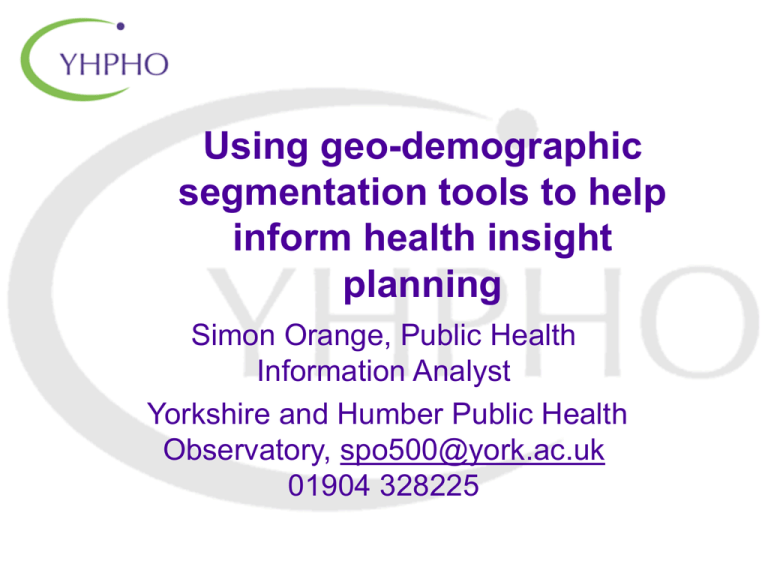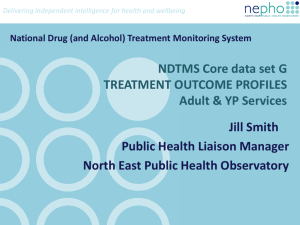Introducing the Yorkshire and Humber Public Health Observatory
advertisement

Using geo-demographic segmentation tools to help inform health insight planning Simon Orange, Public Health Information Analyst Yorkshire and Humber Public Health Observatory, spo500@york.ac.uk 01904 328225 Segmentation • A process of looking at the audience or ‘market’ and seeking to identify distinct subgroups (segments) that may have similar needs, attitudes or behaviours. • The aim of any segmentation should be to define a small number of groups so that: – all members of a particular group are as similar to each other as possible – they are as different from the other groups as possible “Promoting and delivering public health intelligence” Types of Segmentation Demographic - Divides people into groups based on variables such as age, gender, race. Geographic - Divides people into groups based on different geographical units such as regions. Geo-demographic - Combines demographics and geography into a segmentation. Identify groups of small geographic areas that have similar demographic profiles. Behavioural - Divides people into groups based on the way they respond to, use, or know of a product or service. “Promoting and delivering public health intelligence” Geodemographics • Geodemographics has been defined as the ‘analysis of people by where they live’. • Use of geography to help us draw general conclusions about the characteristics and behaviours of the people who live in them. • Similar people live in similar places, do similar things and have similar lifestyles ‘birds of a feather flock together’. “Promoting and delivering public health intelligence” Geodemographic Segmentation Charles Booth’s 1898-99 Poverty Map of London Webber and Craig (1976 & 78) • Office of Population Censuses and Surveys (OPCS) commissioned three classifications based on the 1971 census. • Key variables used included unemployment, students, two car households, industry sector, social class, age, migration, tenure, overseas immigration, overcrowding and household amenities • Commercial sector saw potential benefits of area classification. The British Market Research Bureau (BMRB) restructured Webbers classification and renamed it ‘A Classification of Residential Neighbourhoods’ (ACORN). http://booth.lse.ac.uk/ http://www.geog.leeds.ac.uk/people/old/d.vickers/d.vick ers_thesis_c2.pdf “Promoting and delivering public health intelligence” Tool Creation % of variance explained V1 Variables are chosen and refined 100% Data is standardised Clusters are created 80% 60% 40% 20% Clusters are are Number of 0% Clusters named and clusters are named and profiled 25 30 35 profiled 5 10 15 20 chosen Cluster numbers V2 “Promoting and delivering public health intelligence” Tools Available “Promoting and delivering public health intelligence” Segmentation Profiles “Promoting and delivering public health intelligence” Example of Profiling cervical screening for Yorkshire and the Humber: “Promoting and delivering public health intelligence” Example of Profiling cervical screening for Bradford: “Promoting and delivering public health intelligence” Segmentation Profiles All Leeds Deliveries Under 18 Leeds Deliveries Baseline Target Profile Profile Struggling families Struggling families Secure Families Burdened Singles Source: HES data “Promoting and delivering public health intelligence” Mapping “Promoting and delivering public health intelligence” Health Intelligence Practice Profiles Logarithmic Scale - % Population within Categories Health ACORN 1.1 4.6 100% Top Category: 4.6 1.2 4.5 4.4 10% 0% 0.1% 31% of the practice population. Affluent towns and villages with excellent health and diet 1.4 4.3 1% 0.1% 1.3 1.5 4.2 1.6 4.1 1.7 2nd Category: 4.4 3.6 1.8 3.5 16.4% of the practice population. Towns and villages with average health and diet 2.1 1% 3.4 2.2 10% 3.3 100% 2.3 3.2 3.1 B84004 B84004 B84004Hebden Hebden HebdenBridge Bridge BridgeGroup Group GroupPractice Practice Practice 2.5 2.4 Calderdale Calderdale Calderdale England England England “Promoting and delivering public health intelligence” Source: CACI Ltd 2007 www.caci.co.uk Identifying areas with excess expected prevalence/incidence “Promoting and delivering public health intelligence” Comparison “Promoting and delivering public health intelligence” How do they add value? • Population health profiling: – – • • Targeting health interventions by identifying areas with excess expected prevalence/incidence etc. Measurement of health inequalities by: – – • • • Understanding the characteristics of small geographical areas. Mapping and visualisation. Explaining variation in health determinants, outcomes or services. Providing a more granular measure of health inequality. Social marketing and communications Support data linkage, and non-disclosable data sharing. As a base for generating additional insight - on top of the off-the-shelf descriptions. “Promoting and delivering public health intelligence” What geodemographics can not tell us. • Birds of a feather may not always flock together • Census 2001 data dependent • Analysis of the profiles is usually based on probabilities, rather than hard data. • Not really intended to be used as a trend monitoring tool. Cannot quickly detect change • Geodemographics in themselves do not provide the answer. They are simply one of a range of tools and approaches that can be used to generate insight and health intelligence to support social marketing decisions. “Promoting and delivering public health intelligence” Simon Orange, Public Health Information Analyst Yorkshire and Humber Public Health Observatory, spo500@york.ac.uk 01904 328225





